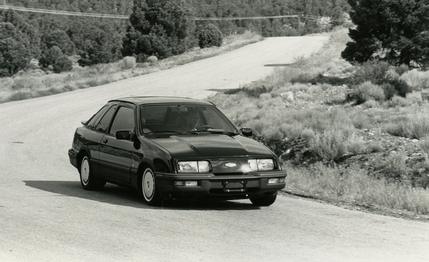 Road Test
Road Test
There is no doubt that the Corvette is the most thoroughly documented car in America. Volumes have been written about it during its colorful, if somewhat checkered, 32-year lifetime, and that is not about to change. As it is obligatory that we continue to add to the reams of trivia generated in behalf of this beloved machine, we now bring you an early peek at the 1986 model - a version that is identical to the 1985 model, save for two major improvements and a few minor details.
First let us deal with the minutiae. In accordance with the whims of the DOT, the new Corvette has a high-mounted brake light. It has been neatly integrated into the targa bar, but it still looks more like a navigational aid for small boats than an automotive safety device. Aside from an assortment of new body colors, the exterior is unchanged. The interior receives only subtle alterations, including a slightly thicker-rimmed steering wheel and a reangled instrument cluster to reduce windshield glare.
The big news consists of two items: a concerted effort to pare down the car's substantial bulk and the addition of a Bosch ABS anti-lock braking system. The principal source of the weight reduction is the use of aluminum cylinder heads, which, combined with the judicious excising of ounces elsewhere, has scavenged about 125 pounds from the chunky beast. Not only does this improve overall handling and acceleration, but the Hardy Boys who serve as the tiny Corvette engineering group are hopeful that fuel economy will be similarly boosted.
This successful visit to the fat farm, however, will surely be overshadowed by the new anti-lock brakes. The installation is indeed impressive, and it indicates that the old "Not Invented Here" syndrome that has infested Detroit will continue to be ignored by Corvette engineers - as it was with the adoption of Bilstein shock absorbers last year.
Although GM's own Delco Moraine Division is developing its own ABS, the West German Bosch unit is certainly the match of any in the world. The whole system - the modulator (mounted behind the driver's seat in a storage well), the wheel-speed sensors, and the plumbing - weighs only about nine pounds, and it's worth every extra ounce. It is essentially the same setup employed by Mercedes-Benz, BMW, and Audi, although it has no on/off defeating capability; the Corvette ABS works under all lockup conditions, whether the driver likes it or not. Presuming the driver is of sound mind, he will like it -- even worship it - under most of them.
The system is undetectable during normal driving. But if you apply the brakes on slippery pavement, or if you are forced to brake hard while trying to execute an in extremis evasive maneuver, the Corvette will tiptoe to a stop, its four wheels locking and unlocking in an uncanny, computer-controlled syncopation that almost eliminates brake-induced skids. We found that it is indeed possible, despite Chevrolet's claims, to make the car spin if one is foolish enough to mash the brake pedal while cornering hard, and it is said that ABS is not the hot tip on undulating gravel roads; but for the normal driver encountering rain-slicked streets, ice, or sleet, or in emergency straight-line stops on dry pavement, it is an answered prayer. It will take a few of these stops to acclimate oneself to the odd, modulating feedback through the brake pedal, but surely this is a small price to pay for such safety.
There is little question that by 1990 similar anti-lock systems will be as common on land-borne vehicles as headlights and fuel tanks. There is also little question that General Motors is devoutly committed to making its plastic Chevy the equal of any car on earth in terms of performance and engineering excellence. In this sense the Corvette with Bosch ABS is a marriage made in fast-driver heaven. And America's favorite sports car, already superb, is for 1986 even better.